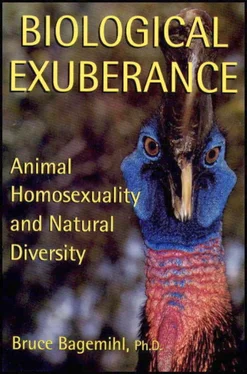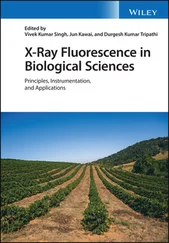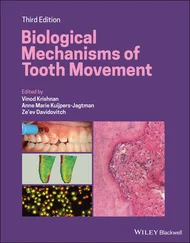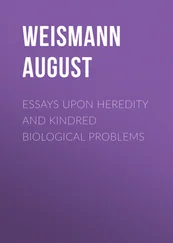…one woman lying on top of another and simulating in movements the act of intercourse… gratifies her masculine component…. Some authorities regard [the partners of these] women… as pseudohomosexuals. The number of sex-starved women who yield to homosexuality… is much greater than one might suppose.
—F. S. CAPRIO,
female homosexuality, 1954
female[s]… occasionally carry out elaborate homosexual pseudocopulatory manoeuvres. Usually one female assumes the male role and mounts another female… and the two animals then perform a remarkably realistic pseudocopulation.
—from a scientific description of Northern Fur Seals, 1959 3
Sadly, such perspectives on animal homosexuality are still prevalent today among both scientists and nonscientists alike. In many cases, people are still reapplying to animals the same outmoded views of homosexuality that were used to condemn and pathologize the behavior in humans throughout most of this century. Such “explanations” have since been shown to be untenable (if not downright laughable) for people, and they should similarly have been abandoned long ago by scientists studying animals.
“Which One Plays the Female Role?”—Homosexuality as Pseudoheterosexuality
One of the most prevalent and pernicious misconceptions about animal homosexuality is that it is simply an imitation of heterosexuality and heterosexual gender roles. 4In numerous species, animals that participate in homosexual interactions are assigned—sometimes arbitrarily—to one of two roles: “male” or “female.” Masculine or feminine, malelike or femalelike, male-acting or female-acting, male mimicry or female mimicry, pseudo-male or pseudo-female are just some of the other terms widely used to refer to the participants in homosexual interactions. 5In other words, homosexuality is seen merely as a replica of heterosexuality—male—female patterns transposed onto same-sex partners. In perhaps the most extreme example of this viewpoint, one scientist actually treated the homosexual couples in his captive population of Orange-fronted and Aztec Parakeets as stand-ins for heterosexual pairs. Because of the rather embarrassing fact that there were more same-sex than opposite-sex pairs in his flock, he used several homosexual couples as male-female surrogates in his experiments on “heterosexual” pair-bonding behavior. For this to work, however, “it was necessary… to assume that in homosexual pairs one bird assumes the role of the male, the other of the female, and that behavioral events between such birds are those typical of heterosexually paired birds.” This assumption entirely disregarded the fact that female pairs in this species differ in important respects from heterosexual pairs (for example by exhibiting mutual, as opposed to one-way, courtship feeding) and probably also hindered the discovery of other such differences. 6
The idea that homosexual relations in animals are necessarily gendered along heterosexual lines has its origins in Freud’s (and others’) view of (human) homosexuality as sexual inversion, the adoption by one partner in a same-sex interaction of the behaviors or roles “typical” of the opposite sex. 7In fact, some zoologists have used the very terms sexual inversion and inverse (or even reverse) sexuality to describe homosexual activity in animals. Desmond Morris developed this idea further with respect to animals in a series of papers in the 1950s, in which he introduced the terms pseudo-male and pseudo-female to describe animals who exhibit behavior patterns more commonly seen in the opposite sex; these terms are still used to this day in scientific publications that describe same-sex activity. 8Also still employed is the analytical framework represented by such terms, which argues that the occurrence of homosexuality in a species can be directly attributed to, and characterized by, opposite-sex or “gender-atypical” behavior. The argument goes something like this: certain animals in a population are prone to “pseudo-female” or “pseudo-male” behavior; that is, imitation of behavioral patterns found in the opposite sex. This mimicking of heterosexuality automatically triggers “homosexual” behavior in individuals who are essentially “deceived” into thinking they are dealing with a member of the opposite sex, hence they respond with sexual or courtship behaviors.
Often, an attempt is also made to correlate sexual “role inversion” with other behavioral or physical traits that are supposedly characteristic of the opposite sex (or of certain gender roles), such as higher levels of aggression in female Takhi and Mallard Ducks that mount other females. One scientist, in describing a male Snow Goose that supposedly adopted the “male role” in a homosexual pairing, even goes so far as to comment on the bird’s “much enlarged penis” in addition to his greater aggressiveness. As we shall see later in this chapter, this is reminiscent of descriptions of human “inversion” from the early sexological literature, which often focused on the appearance of a person’s genitals as somehow indicative of the “abnormality” or pathology of their homosexuality. 9
Reciprocal Homosexuality and Heterosexual “Inverts”
In spite of apparently unabated popularity in scientific circles, a “pseudoheterosexuality” interpretation imposes a restrictive and often erroneous framework on animal homosexuality, and there are numerous arguments against it. 10To begin with, in an overwhelming number of cases homosexual behavior cannot possibly be construed as mimicking heterosexuality. In a number of species, unique sexual or courtship behaviors occur between animals of the same sex that are not found in heterosexual interactions. For example, homosexual but not heterosexual interactions in Bonobos, Gibbons, Stumptail Macaques, Crested Black Macaques, West Indian Manatees, and Gray Whales often involve mutual genital rubbing or manual and oral stimulation of the genitals. 11The actions of both partners are often identical or reciprocal, and therefore neither animal can be construed as adopting a stereotypically “male” or “female” role. 12In species such as Bottlenose Dolphins, Cheetahs, and Grizzly Bears (among others), same-sex pair-bonding occurs to the exclusion of opposite-sex pairing; thus, the “roles” of individuals in homosexual pairs cannot be modeled after male-female (heterosexual) “roles” because there simply are no such models in these species.
Even for animals where identical or similar behaviors occur in both homosexual and heterosexual interactions, the same-sex activities often do not fall neatly into the gendered patterns expected under a “pseudoheterosexual” interpretation. For example, homosexual mounting is often reciprocal, which means that the animals take turns in the mounter/mountee positions, with neither preferring exclusively “male” or “female” roles. Various forms of reciprocal mounting have been documented in at least 30 species (and probably occur in many more): simultaneous reciprocity, in which the partners exchange roles during the same mounting bout (as in Pukeko or Black-rumped Flamebacks); and sequential reciprocity, in which partners trade roles at different points in time—the latter can involve frequent alternation over an extended period as in Japanese Macaques, or perhaps a onetime switch as has been reported for some Bottlenose Dolphins. Moreover, in many species heterosexual mounting can be “reversed” or “inverted,” in that the female mounts her male partner. Thus, the “mounter” and “mountee” positions cannot be absolutely equated with fixed “male” and “female” roles even in opposite-sex interactions. Most “pseudoheterosexual” interpretations of homosexuality, therefore, involve stereotyped views not only of same-sex activity but also of male-female relations. 13
Читать дальше












